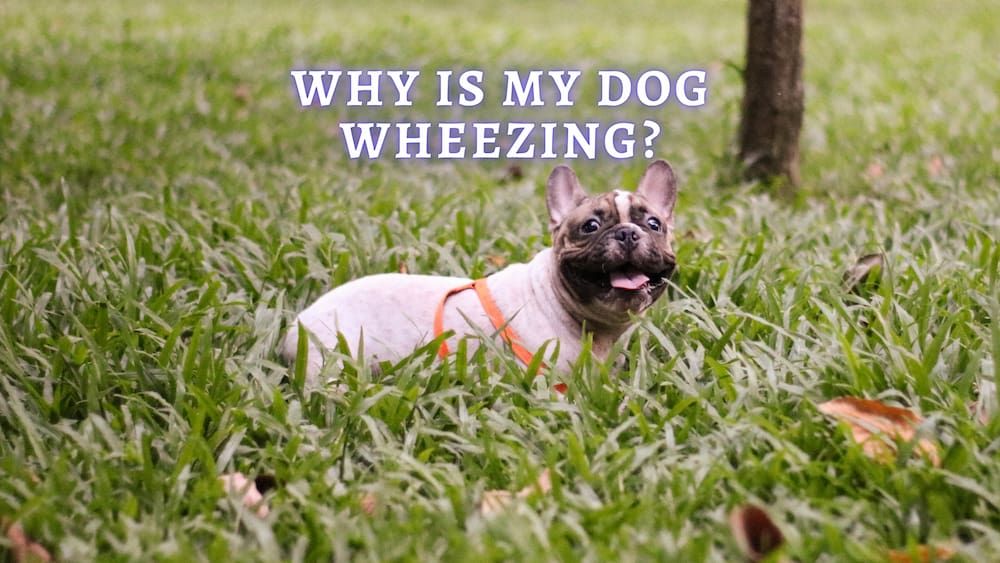Dog Wheezing: 6 Reasons Why Your Dog Is Wheezing (Vet-Approved Advice)
Written by:
Author: Seb Jenkins
Seb is a professional SEO writer with a degree in Journalism, he has five years of experience in writing and editing. Seb specializes in topics like dog and cat breeds, aquarium guides, and pet care. He is passionate about educating and entertaining animal owners worldwide. In his spare time, Seb enjoys writing fiction novels.
View all 83 articlesLearn about our editorial process and veterinary review board.
Reviewed by:
Veterinary review
by Dr. Linda Simon
Dr. Linda Simon is a veterinary surgeon working with seven years of experience. She is a fellow of the British Veterinary Association and specializing in animal medicine. Also, she has been the Woman magazine resident vet for the past two years and writes a regular column for them, focusing on pets and their health.
View all 30 articlesLearn about our veterinary review board
Viewed: 64
Updated on: 06/08/2023
As pet owners, we all keep a constant ear out for the noises our animals are making. After all, they can’t speak to us in our own language, so we can only decipher when something is wrong through their behavior and sounds. While sneezing is a normal part of being a dog, the same cannot be said about wheezing.
Several underlying severe causes could be behind canine wheezing, so you must take them to the vet when you notice something is wrong. Fortunately, we have created an all-you-need-to-know article on the causes of wheezing and how you should react as a dog owner.
Common causes of wheezing in dogs
There are six common reasons behind dog wheezing, so let’s look through each to prepare you for the information your vet may provide.
1. Allergies
Seasonal allergies are common and tend to present between the ages of 2 and 5. When allergens appear, your dog may sneeze and develop runny eyes and nose. Wheezing would occur in more severe cases. This is especially the case during walks when your dog comes into contact with plants or if you have many plants around the house. Other contaminants including cooking fumes and cigarette smoke, can also cause allergic reactions in the same way. Your vet should be able to give you more information on how to deal with dog allergies.
However, it is also essential to know the risks of anaphylaxis. Sometimes, when a dog comes into contact with an allergen or is bitten or stung, it can have a more severe allergic reaction known as anaphylaxis. Signs come on rapidly and can include pale gums, collapse, hives, and breathing difficulties, in which case you should take them straight for an emergency appointment at the vet.
2. Heart Disease
Heart diseases are more common in older dogs, and congestive heart failure can occur secondary to, e.g., mitral valve disease or dilated cardiomyopathy. One of the symptoms of heart disease is wheezing and coughing, which is something to look out for. When heart diseases get worse, fluid can build up in the lungs of your dog, which causes heavier wheezing and coughing. They may even cough up some liquid during wheezing fits. While there is no cure for a heart problem like congestive heart failure and it is progressive, it can be managed with medication and lifestyle changes. So, contact your vet to determine the best course of action for you and your pet.
3. Collapsed Trachea
Smaller dogs, especially those with short noses, are known to have breathing problems, which can worsen as the dog ages. A collapsed trachea is something we see in older brachycephalic dogs, and it occurs when the trachea cartilage becomes too weak, causing the airway to shrink and narrow. Fortunately, it can be managed with expert treatment for most dogs, so book an appointment with your vet.
If you have been told that your dog has a collapsed trachea, you may notice the wheezing getting worse when they are particularly active or excited. You will also likely hear your dog snoring while they sleep. All you can do is contact your vet and come up with a health plan to make sure your dog is as comfortable as possible. This may include weight loss, the use of a body harness, cough suppressants, and anti-inflammatories.
4. Bronchitis
Bronchitis can be caused by several things, including allergies and infections. Chronic bronchitis can lead to your dog’s airways getting scarred, which in turn causes wheezing and coughing. Vets often give dogs steroids and/or antibiotics to combat bronchitis to target the problem as aggressively as possible.
5. Something In Their Throat
If your dog is wheezing a lot, there is a chance that they have inhaled or ingested something it shouldn’t have. They may find something in the yard, like a grass blade or awn, a piece of bone that has broken away, a piece of one of their toys, or something else. Whatever they have trapped in their throat should be seen as an emergency, and you need to take them straight to the vet.
Other symptoms of an obstructed airway include distress, salivating, retching, and pawing at the mouth.
If your dog has something stuck in their throat, it may be blocking its airways which causes the wheezing sound. Difficulty breathing can quickly lead to a dog passing out, especially if its airways are fully secured. If they are partially blocked, the wheezing indicates difficulty breathing. They may also seem very anxious and have the inability to relax.
6. Infectious Disease
The final common cause of wheezing in dogs is an infectious disease caused by e.g., bacteria, parasites, or a virus. Many diseases and problems can result in wheezing, although some are more common. One to watch out for is heartworm, which can infect the dog’s lungs. Kennel cough is also known to cause wheezing and can be particularly prevalent in dogs who spend a lot of time around other dogs, hence the name. One of the best things you can do to protect against these diseases is to have your dog vaccinated and updated on their parasite prevention.
RELATED: Pneumonia in Dogs (Vet Advice)
What does dog wheezing sound like?
Wheezing noises should be pretty self-explanatory. We all know what wheezing sounds like in humans – it’s just the dog version. Instead of quiet and effortless breathing, it becomes high-pitched and almost musical. Wheezing can be very alarming to hear from your little four-legged friend and stands out against sneezes and coughs. You will often hear a high-pitched whistle when your dog exhales if they are gasping because they are having trouble breathing as it usually would.
How to prevent my dog from having respiratory problems?
There are a number of things you can do to prevent or treat your dog’s respiratory system problems. However, any sort of wheezing warrants a prompt vet visit.
You can also prevent the risk of some diseases by vaccinating your dog and keeping them up to date with their parasite prevention.
If you think your dog’s wheezing is caused by mild allergies or a viral infection, you can:
- Get rid of any irritants that may be causing the allergies.
- Clean your house often to get rid of dust.
- Give your dog a bath if they are irritated by something on their fur, like pollen.
- Clear their airways with steam. You can have your dog spend 5 minutes in a room where someone has just had a hot bath or shower.
- Feed them a healthy and balanced diet.
- Make sure they drink lots of water.
- Clean away any nasal discharge with a wet, warm piece of cotton wool.
- Wrap them up warm while outside in the cold.
- Make sure they get enough rest.
To potentially prevent wheezing in the future, there are some changes you can make to your home life. One of the best things you can do is strengthen their immune system by ensuring they stay fit and healthy.
That means lots of exercise, healthy eating, grooming for cleanliness, and lots of water to stay hydrated. If they have a weak immune system, they are more at risk of disease.
It is also important to take them for vet check-ups regularly. Before you administer any treatment for wheezing, always get approval from your vet first to ensure it is safe and effective. They will likely be able to tell you what is causing the wheezing and what the best course of action is to help your dog.
The more you keep an eye on your four-legged friend and learn their behaviors, the easier it will be for you to tell when something is wrong and the quicker you can react to any wheezing-related problems by taking them straight to the vet.
- Get rid of dust and other aeroallergens with an air purifier.
- Not smoking near your pet.
- Using an extractor fan when cooking.
- Wrap them up warm when outside in the cold.
- Use a body harness rather than neck collar when out on walks.
- Avoid foods and treats that may irritate their airways.
- Make sure they stay fit and healthy and the correct Body Condition Score.
- Make sure they are vaccinated, up to date with parasite prevention and visit the vet regularly.
When to worry about wheezing –
There are a number of tell-tale signs to watch out for when it comes to a wheezing dog. If you see any of these symptoms, then you should take them to the vet as a matter of emergency.
- Gasping for breath – If your dog is clearly having serious trouble breathing then it can be a sign of something life-threatening and they should be taken to the vet immediately.
- Gagging – If your dog is gagging while they wheeze, it may signal that something is stuck in their throat and blocking their airways. This is a medical emergency.
- Coughing – If your dog is coughing and wheezing at the same time, it may point towards some kind of respiratory infection, something stuck in their throat, lower airway disease, kennel cough, or something else serious.
- Blue gums or tongue – If your dog is wheezing and also has blue gums or a blue tongue then it is a sign they are not getting enough oxygen into their body. Immediate medical attention is needed. Their gums should be a salmon pink color.
- Heavy and/or fast breathing – If your dog is breathing hard and fast while wheezing, it can be a sign of a number of diseases or conditions. An immediate trip to the vet is required. When resting, a dog should breathe less than 30 times a minute.
- No appetite – If your dog is both wheezing and not eating as normal, it can point towards a serious problem or infection. Take them to the vet right away.
- Consistent wheezing – If your dog’s wheezing is consistent and is not improving, they should be taken to the vet to see what’s wrong.
- Lethargy or trouble keeping up on walks. Any change in energy levels is a red flag.
- Abdominal bloating. This can be a sign of fluid build-up within the abdomen.
How to treat a wheezing dog
If you notice that your dog is wheezing or showing any of the symptoms mentioned above, then it is important to take the correct next steps to keep them safe and healthy. Ultimately, your dog needs to end up at the vet, but there are other things you can do along the way to help them.
- Stay calm – If you are calm, then your dog will stay calm. If you panic, your dog will panic, and their breathing difficulties will only get worse.
- Airflow – Take your dog to the part of your home with the best airflow so they can have a good supply of oxygen.
- Triggers – Get rid of any potential triggers in the direct area. This can include plants, scented products, candles, sprays, air fresheners, etc. If you are outside around wildlife and plants, then bring them inside.
- Video – Take a video of your dog to show your vet. It can be helpful for the vet to see and hear the dog when they are struggling in order to diagnose and help them. By the time you arrive at the vet, your dog may not be showing the same symptoms.
- Vet time – Take your dog to the vet if their symptoms continue.
The cause of the wheezing may be something simple like allergies, which are easily treatable. However, it could also be something more serious, which is why it is always better to be safe than sorry and take them to the vet. The emergency vet clinic should be your destination if you suspect your dog has something stuck in their throat or if they are suffering from anaphylaxis and your vet is not immediately available.
People Also Ask
Should I be worried if my dog is wheezing?
Wheezing can indicate serious health problems in a dog as it is an indicator of narrows airways and difficulty with breathing. While it may be a sign of something simple like allergies, you should always take your dog to the vet immediately if they show consistent wheezing and any other symptoms highlighted in this article.
Why is my dog making a weird wheezing sound?
Wheezing can indicate a number of problems including allergies, a collapsed trachea, heart disease, something stuck in the dog’s throat, bronchitis, or a number of other diseases. Take your dog to the vet immediately to find out more.
How can I help my dog with wheezing?
The best thing you can do is take them to the vet to get all the information. Treatment may include oxygen, anti-inflammatories and/or antibiotics.
What are the signs of respiratory distress in a dog?
The signs of respiratory distress include gasping for breath, gagging, coughing, blue gums or tongue, heavy and/or fast breathing, no appetite, or just consistent wheezing.
 Dog Care Do Dogs Get Tired of Barking? 10 Common Reasons for Dog Barking and How to Stop It
Dog Care Do Dogs Get Tired of Barking? 10 Common Reasons for Dog Barking and How to Stop It - 319
- 0
 Dog Veterinary Tips Why is my Dog throwing up: Causes and Preventing (Veterinary Advice)
Dog Veterinary Tips Why is my Dog throwing up: Causes and Preventing (Veterinary Advice) - 23424
- 5
 Dog Care Why Is My Dog Bleeding From Its Butt? Causes and treatment of rectal bleeding in the dog
Dog Care Why Is My Dog Bleeding From Its Butt? Causes and treatment of rectal bleeding in the dog - 22076
- 0
 Dog Care My Dog Keeps Scratching His Mouth: Reasons Why Your Dog Scratching Face
Dog Care My Dog Keeps Scratching His Mouth: Reasons Why Your Dog Scratching Face - 17561
- 1























